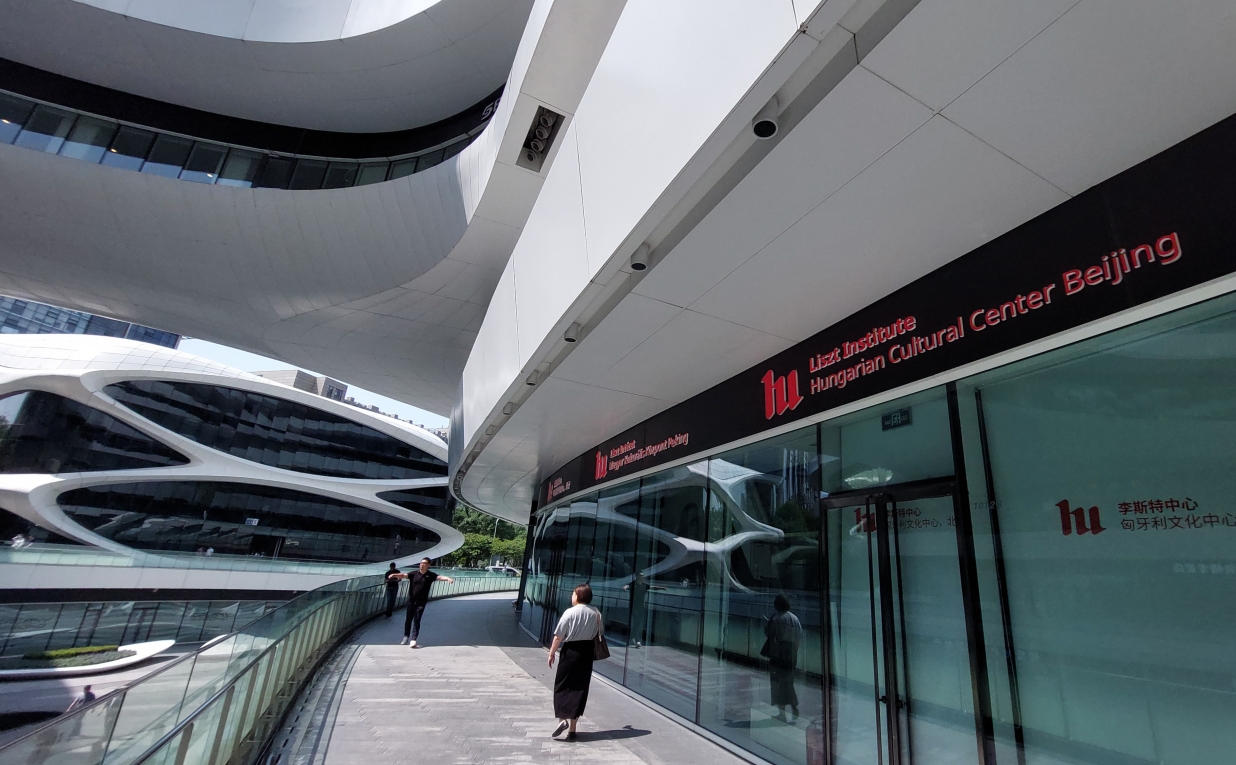
Contribution that Hungarians have made in the past is still remembered and revered in the former capital.Continue reading

Only days after the visit of Chinese President Xi Jinping to Hungary in May, the Hungary Today team has visited the Liszt Institute, the Hungarian Cultural Center, in the Chinese capital Beijing. We asked its director, Anna Lujza Honecz, about the Institute’s goals and achievements. As we have subsequently learnt, the Rubik cube, the renowned Kodály method or indeed paintings with postal stamps – these are all on the menu here.

Anna Lujza Honecz, Director of the Liszt Institute Beijing. Photo: Hungary Today
The Liszt Institute in Beijing is in its eleventh year, what has been achieved in the past decade, including February 2024, since you have been running the institute?
Ten years ago this whole venture had started from scratch, when the first director of the institute, Dr. Andrea Szonja Buslig built this whole institute from next to nothing. In the past ten years though, we have become one of the best known foreign cultural institutes here in China.

Architect Zaha Hadid’s Galaxy Soho in Beijing hosting the Liszt Institute. Photo: Hungary Today
How can you measure the cultural center’s popularity?
People in this field know our name, our programs are very well attended. This is despite the fact that we obviously work on a much smaller scale in comparison with the Goethe Institute or the French Institute. Nevertheless, I think that our followers take a very active interest in our programs, both Hungarian and Chinese.

Cimbalom Evening with the Chinese Conservatory of Music. Photo: Liszt Institute
Where do you see most clearly that the work you have put into this cultural institution has been worth it?
I believe that culture is always worth investing in because it is the foundation of everything else. Culture is soft power, it allows us to build good relations in other areas, and it also builds a positive image of our country. The feedback is good, for example, students come to us, show interest in our work, and subsequently they go to Hungary to study. We also had a success story at the beginning of the year, when we were approached by a Chinese agency for educational exchange. We gave them some advice on how to get started, and now at the beginning of the year they have reported back to us that they have had a successful winter university program and have already set up an office in Budapest.
There are a lot of tours heading to Hungary and sometimes we have tour operators coming in to ask for information, who wish to know something specific about our country. Helping them is part of our work. Sometimes these groups come back and contact us by messages to say how much fun they had. That is what makes it worthwhile.
So there is both an educational and tourism dimension to your work…
Definitely, since tourism is part of culture. If they visit us, obviously they can learn about our culture.
How would you sum up the purpose of the Liszt Institute here in Beijing? What you are doing is very diverse, but what is the ultimate goal of all these efforts?
If I want to simplify it, it is obviously to present Hungarian heritage and cultural values here in China. We aim to share these with the citizens of our host country. Then there is another one, which I think is very important, and that is to create a platform for Hungarian artists and Hungarian performers to present themselves here in China. This is a way of establishing contacts, of forming bridges. We are often approached by private individuals, institutions or even government bodies when they are looking for suitable partners, and we try to help them.

Kodály method teacher training in cooperation with the Deqing Foundation in Chongqing, where over 300 teachers attended the course. Photo: Liszt Institute
There are language courses in a number of cultural institutions abroad, do you offer something like this for those wanting to study Hungarian?
We do not. Instead we have the Kodály Point where music is taught, but there are more and more universities in China where you can indeed learn Hungarian. There are one or two where it is a second foreign language, but there are others where there is a regular Hungarian course. In Beijing, for example, there are three universities that have been teaching Hungarian for a long time, and we have very good relations with all of them. On 15 March, our national holiday, we had a program where we invited students learning Hungarian from all three universities to a joint commemoration in the garden of the Lu Xun Museum at the statue of poet Sándor Petőfi. Here they could meet their peers who are also studying Hungarian at other universities.
Do they find the Hungarian language difficult?
It is hard to answer that, everyone starts from a different background. Some people have a better grasp of the language, and the same goes for those who are trying to learn Chinese.
Let us talk a little about the Kodály Point. You mentioned that this is at the heart of your activities. How familiar are the Chinese with the Kodály method, since, if I am not mistaken, it was present in China long before the Liszt Institute existed?
This method of music education is spreading rapidly and there is a growing interest in it. Our Kodály Point has been open since 2015 and we currently have one teacher. The classes are held on weekends, taught by Edit Lánczky, and she is now able to give these classes in Chinese. That makes a difference here. We get requests from all over the country, which is why we have introduced the hybrid, online format. We have Kodály choir sessions for children on weekends and choirs at outside venues during the week. For example, we go to schools, our instructor Edit leads choirs there as well, but we also have teacher training courses that shows the Kodály method to teachers online.
We used to hold a Kodály course for teachers in Chongqing (population 32 million), for instance, with 280 teachers currently participating. We were very happy about this success, and we continue to try to participate in as many such activities as possible. It is all on a non-profit basis, and Edit mainly goes to areas that are more disadvantaged. Where children do not have the opportunity to participate in a non-Chinese type music education, and where teachers do not have much opportunity to go for further training. The feedback is very positive, the teachers really like Edit. And of course there are tangible results. Sometimes we get feedback months later informing us that there have been teachers who have completed the course and won prizes in music competitions.
It is, however, impossible to meet the needs of such a large country with just one teacher, the demand for our music lessons is such that we can not possibly meet it entirely.

Imperial Palace, Forbidden City, Beijing. Photo: Hungary Today
How much can we build on the success of the Kodály method here so that it becomes a bridge through which we can strengthen Hungarian relations with China in a broader sense?
It can certainly be used for this purpose. We are fortunate that the Chinese have such a strong sense of music, that it is a very important part of their everyday lives. They love to listen to music, they love to sing, the music industry is booming here, and we can relate to that very well, because there are similarities between Chinese and Hungarian folk music. There is pentatonic scale in both, and they recognize that melody, hence it resonates with them. Through this we create a linkage – Chinese teachers use Hungarian-style music education, and we also benefit from that.
Chinese President Xi Jinping was on a three-day visit to Hungary in May. What was the response here, did you sense a growing interest in the Liszt Institute’s activities? Do you think this will pave the way for a new level of cooperation between our countries?
Fortunately, there was already a lot of interest in our work, but around the visit there was a noticeable increase in inquiries. We are very pleased about this. We had a lot of requests for interviews, and the questions we were asked were mostly of a more general nature regarding Hungary. We also had a video interview with CGTN in English, where our teacher spoke about music education.
This visit by the Chinese Head of State was also linked to the 75th anniversary of the establishment of relations between China and Hungary. Have you organized any events commemorating this?
In fact, we are trying to organize the whole year in the spirit of the 75th anniversary. We are currently running the Hungarian-Chinese national Rubik’s Cube competition, we are doing it together with the Chongqing Rubik’s Cube Association. Hungarians would be surprised to know how popular Rubik’s Cube here is. Contestants can solve the cube blindfolded, with one hand, or by even their feet. It is a 60-round competition here in China, very popular with the kids.
We are also organizing an exhibition by Judit Szendrei, who is best known for using postal stamps in her artwork. She has also made a special painting for this Chinese exhibition: because this year is also the Year of the Dragon, she has made a 13-part artwork for it.
Music is dominant yet we try to pay attention to all artistic fields. There are visual exhibitions, there are film screenings, theater performances, children’s activities, astronomy program, dance, and others.

Beihai Park, White Pagoda, Beijing. Photo: Hungary Today
When you meet the locals, is there anything they already know about Hungary? Is Hungarian culture or history part of the Chinese curriculum?
They have definitely heard about Hungary, the older generation knows about the revolutionary poet Sándor Petőfi, for example. They must have learnt it a long time ago, yet they know the poem “Freedom and Love” by heart. It always fills my heart with warmth that they know this Hungarian poem and that they express their love for it.
Composer Franz Liszt is also well known in China. He is very much respected, and many students come to us and say that they would like to study at the Franz Liszt Academy of Music in Budapest. Football fans then of course know about Ferenc Puskás.

Galaxy Soho, Beijing. Photo: Hungary Today
Are there any lectures about the Hungarian political system, society, etc. geared towards adults, people who have a deeper knowledge of geopolitical and historical issues?
We also try to do such programs, we try to link them to specific anniversaries. For example, this year is the round anniversary of our traveler Sándor Kőrösi Csoma, we organize programs related to him in cooperation with the embassy. But we also have programs depicting our country, especially for children. Groups of 25-30 children come here, first they receive a written Chinese brochure about our geography, the main attractions, and we show them folk dancing and Hungarian cuisine on video. At the end, they learn a Hungarian folk song together.

Imperial Palace, Forbidden City, Beijing. Photo: Hungary Today
Is there a Hungarian diaspora in China? If so, what are their numbers, because they seem to be almost invisible.
There was a decline in the size of the diaspora during the pandemic. Recently, the number of Hungarians here has started to grow exponentially. I am talking about Hungarians who do not just come here as tourists, but work and study here. It is mostly students, as now you can get scholarships again. The permanent Hungarian community is very small though, but we also try to create programs for them. We occasionally host a Hungarian Club where people can meet.
Featured Image: Hungary Today